
Let’s call out the reflex that still haunts too many teams: shipping a product tour and calling it “onboarding.” In 2025, that’s table stakes. Activation is the new growth mandate — the precise moment a user first feels your core value. Hit it early and you buy retention, expansion, and reputation. Miss it and your CAC quietly lights itself on fire. What you need is the right No‑Code Onboarding solution.
Why did activation get harder and more important? Because two curves crossed:
The answer isn’t “less friction.” It’s earned friction – timely, contextual guidance that adapts to what each user is trying to do. That’s where AI finally matters. Automation and personalization have converged into something practical: onboarding that reacts in real time, without a 40‑step rule engine maintained by a single heroic PMM.
This guide is a practitioner’s comparison of Product Fruits with seven familiar names: Pendo, Whatfix, Chameleon, Userpilot, Appcues, Userflow(s), and UserGuiding. We’ll keep it simple: what each does well, where it bites back, and when Product Fruits is the better choice (and when it isn’t).
Product Fruits is an AI‑powered product adoption platform that lets non‑technical teams build and iterate onboarding without engineering. You can design tours, tooltips, hints, checklists, announcements, a built‑in knowledge base, and in‑app surveys, then personalize all of it in real time.
Your form isn’t your growth engine. Your product experience is. And Product Fruits helps you build a world-class product experience.
Choose a platform that makes it easy to design, aim, learn, and adapt — fast.
Here, we will take a look at how Product Fruits compares to Pendo. Here’s the TLDR:
TL;DR — When to Use Pendo vs. Product Fruits
Use Pendo if your organization needs deep analytics, enterprise-wide governance, and AI‑assisted onboarding at scale. It’s ideal for large teams managing multiple products where advanced event tracking, segmentation, and reporting drive strategic insights — but it requires data maturity, training, and bigger budgets.
Choose Product Fruits if you want a lightweight, all‑in‑one onboarding suite that includes tours, surveys, tooltips, announcements, and a native knowledge base. It’s built for smaller or agile SaaS teams that value speed, simplicity, and transparent MAU‑based pricing. Product Fruits gets you from signup to in‑app guidance in hours, while Pendo shines when analytics depth and enterprise governance are top priorities
1. Pendo has Deep, Retroactive Product Analytics
Pendo captures event-level user data retroactively from the moment it’s installed — even if goals or events weren’t predefined. This means you can uncover detailed insights into user journeys, feature adoption, and engagement trends without heavy upfront setup. Ideal for answering complex retention and usage questions with minimal data prep.
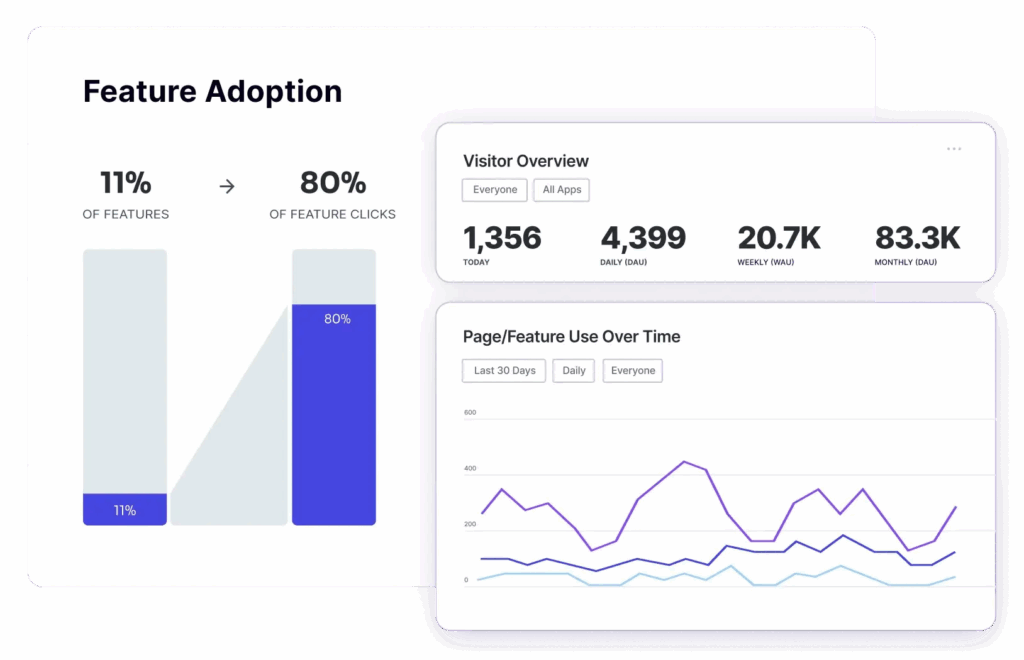
2. Pendo gives Advanced Segmentation and Enterprise Governance
Built for scale, Pendo enables granular user segmentation by behavior, demographics, and feedback. Its governance controls allow multiple teams to collaborate safely across products, while org-wide dashboards align stakeholders on activation and adoption KPIs. Perfect for large teams managing multiple onboarding and analytics streams.
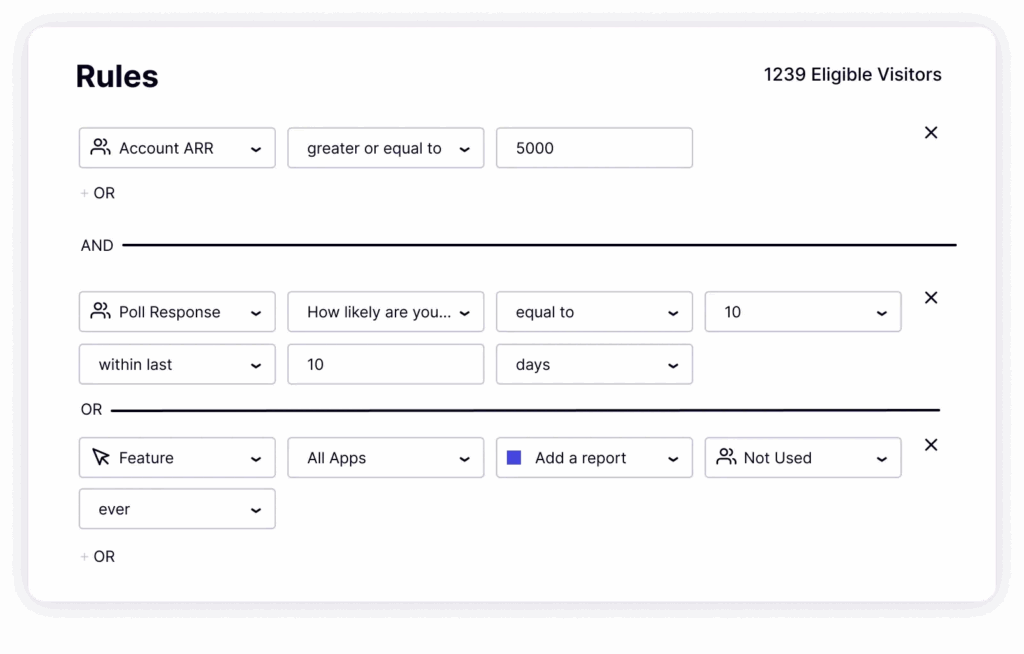
Pendo’s in-app guidance works across web and native mobile apps, giving teams a unified onboarding approach. The no-code builder uses templates and drag-and-drop editing to simplify creation, while AI-assisted guide generation recommends optimal flows and copy based on user behavior — reducing manual effort and accelerating activation cycles.
TL;DR: Pendo excels when enterprise analytics, scalable governance, and AI-assisted onboarding matter most.
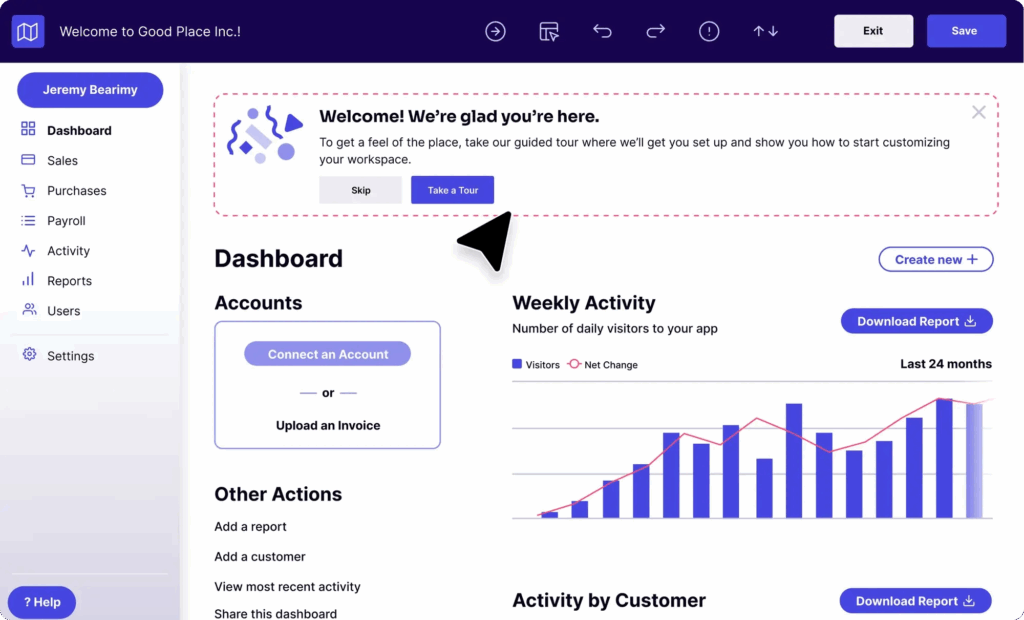
1. Pendo Requires product analytics maturity and onboarding team enablement – To fully leverage Pendo’s advanced analytics and segmentation, teams often need a decent level of product analytics maturity and expertise in data interpretation. Onboarding teams may require training or enablement to build and maintain effective data-driven onboarding flows, which can initially slow adoption and reduce short-term impact.
2. Pendo has No native knowledge base, reliant on integrations – Pendo does not provide a built-in knowledge base solution. Customers must integrate external knowledge base platforms, leading to managing and maintaining two separate systems. This can complicate analytics reconciliation and create fragmented user support experiences requiring additional coordination.
3. Pendo has Custom pricing with potential opacity and premium costs – Pendo’s pricing and packaging are customized based on company size, user volume, and feature needs, often requiring early stakeholder alignment to approve budgets. Pricing is not transparent upfront and can involve premium quotes for enterprise-level features, which may stall procurement or lead to over-investment for smaller teams.
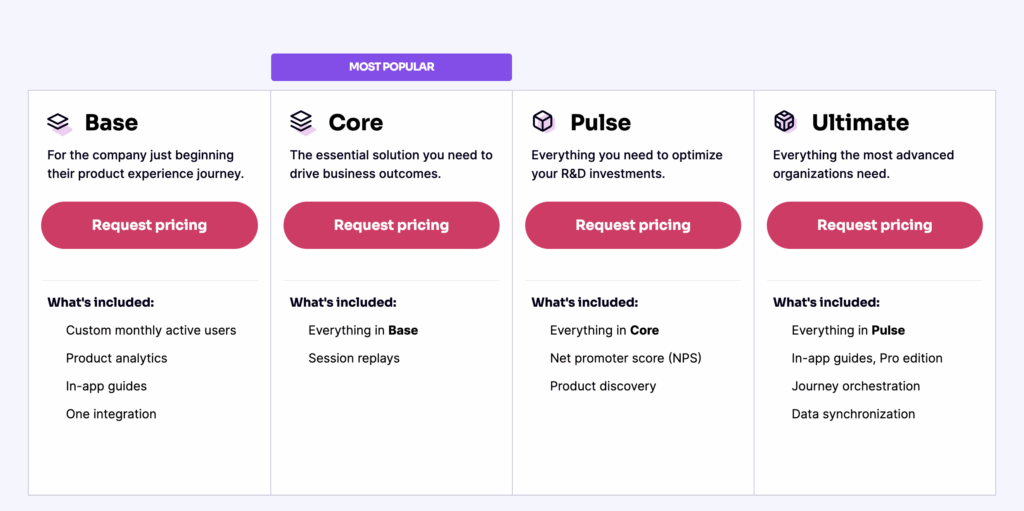
4. Pendo’s Complexity can be a barrier for lean teams – Given Pendo’s comprehensive feature set designed for enterprise-scale usage, some startups or smaller product teams may find the platform overwhelming or too complex for rapid onboarding needs, with longer setup and adjustment periods.
1. Product Fruits is simple and lightweight – With Product Fruits, you get a single, lightweight platform to handle onboarding tours, feature announcements, surveys, in‑app tooltips, and a searchable knowledge base without stitching together multiple tools. Your PM, PMM, or CS lead can update it weekly without engineering sprints.
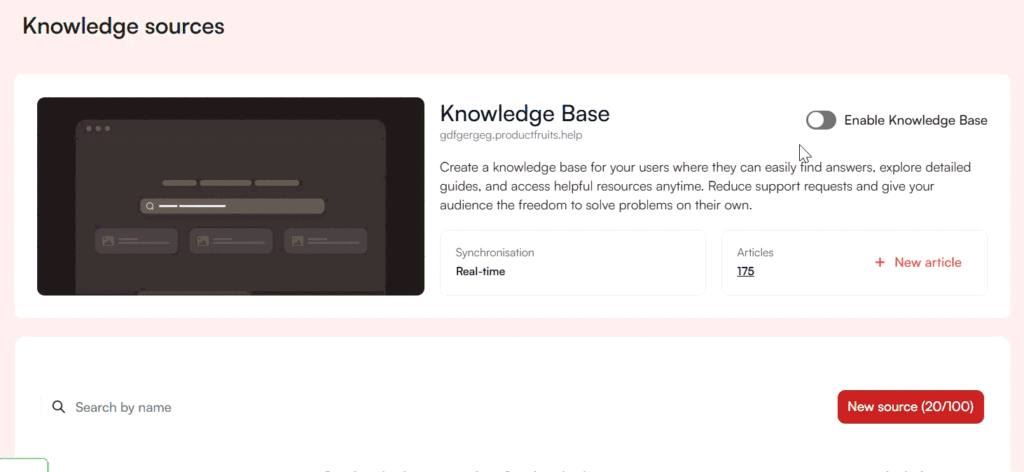
2. ProductFruits has simple transparent pricing – You get predictable, transparent MAU‑based pricing that scales cleanly with your user base — and want to avoid long enterprise procurement cycles, custom quote negotiations, or the uncertainty of hidden fees.
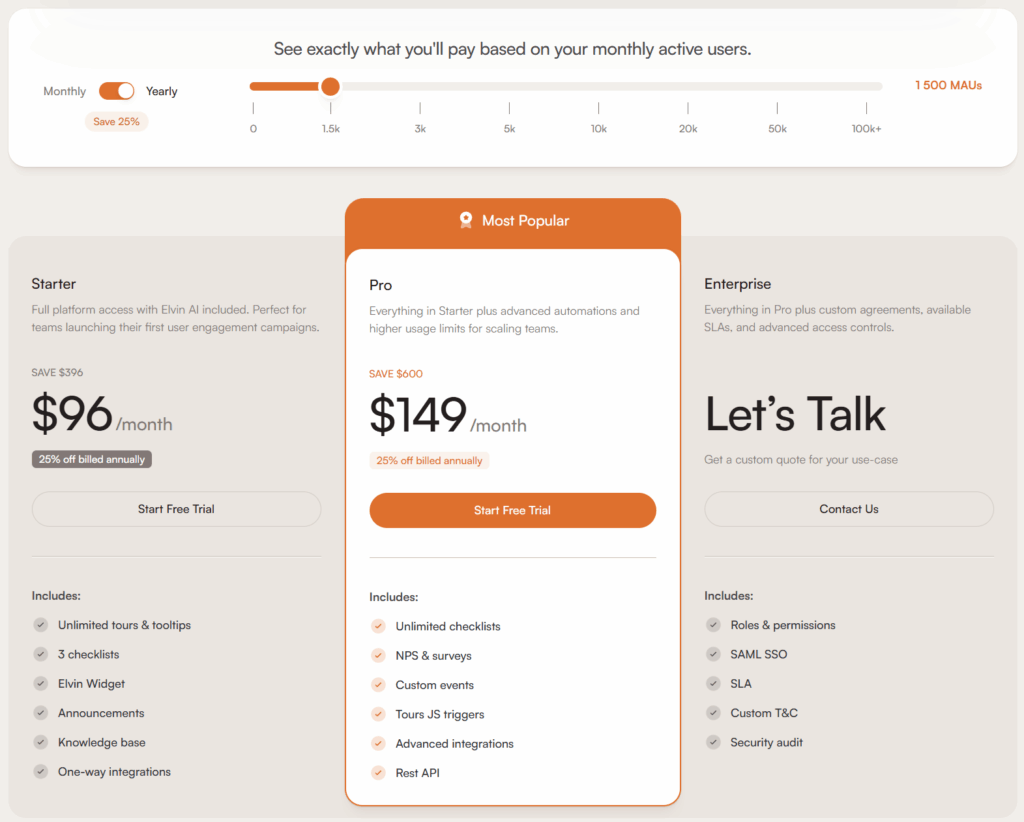
3. ProductFruits helps you iterate faster – If you value rapid iteration and ease‑of‑use over an exhaustive product analytics stack. Product Fruits gives you actionable, AI‑assisted “next best action” recommendations without requiring months of tagging and event mapping.
4. ProductFruits helps you ship faster because of its easy learning curve – Your onboarding team needs to start creating guides and tours within hours of sign‑up, not after a lengthy enablement and training program. With Product Fruits, the learning curve is minimal, and non‑technical teams can own the workflow end‑to‑end.
5. ProductFruits works for both desktop web and mobile web – You operate on both desktop and mobile but prioritize speed over deep customization. Product Fruits delivers consistent in‑app guidance experiences without demanding deep internal dev resources.
6. ProductFruits focuses on user activation that drives lifetime revenue – Your product’s success depends more on guiding new users and collecting direct feedback than on complex segmentation reports or historical analytics. Product Fruits was designed for user activation, not just analysis.
7. ProductFruits has an in-built knowledge base: Product Fruits keeps your knowledge base native to your onboarding tool so analytics, updates, and content all live in one ecosystem — no need to sync, reconcile, or maintain a separate KB platform.
8. Product Fruits has low time-to-value to get the ball rolling – You care about time‑to‑value: Product Fruits can deliver a fully functional onboarding experience in days, whereas enterprise‑scale platforms like Pendo can take weeks or months to configure.
“For a product like FLOWN, highly personalized in-app communication with our users is crucial to our success. By delivering the right messages and content at the right time to the right users, we’ve significantly enhanced engagement and improved product adoption. Product Fruits has also reduced time to value for new users, helping them quickly recognize the benefits of our platform” – Guy Brockless, Product & Strategy.
Here is a clear side-by-side comparison table for Product Fruits vs Pendo, highlighting feature, value, and usage differences relevant to onboarding and product adoption scenarios.
| Feature/Aspect | Product Fruits | Pendo |
|---|---|---|
| Onboarding Tours/Guides | Interactive, AI-powered, all native, rapid setup | Interactive, web & mobile, retroactive analytics |
| Knowledge Base | Built-in, native, linked to tours and help | Integration required, not native |
| Surveys & Feedback | Built-in NPS/surveys, easy targeting | NPS, CSAT, custom—often upgrade/add-on |
| Pricing | Transparent MAU-based, starts ~$129/month | Opaque, seat- and enterprise-tier, premium pricing, extra for add-ons |
| Customization | Advanced CSS, fonts, colors, branding | Limited branding options |
| No-code Content Creation | Yes—PMs/marketers can use without engineers | Yes, but analytics and segmentation setup steeper |
| Event Analytics | Lightweight, basic insights, guided actions | Deep, event-level, segmentable, retroactive, exportable |
| AI Assistance | AI “next best action,” auto-content optimization | AI for guide creation and analytics, more complex |
| In-app Communication | Announcements, surveys, release notes all native | In-app guides, less immediate messaging |
| Ease of Use | Quick setup, dedicated CSM | Steep learning curve, enablement needed. |
| Value for Money | No hidden fees | Premium pricing often cited as barrier |
| Customer Support | Dedicated onboarding and migration help | Reliable for enterprise, less for smaller teams |
Decision rule: If your top constraint is time and focus, pick Product Fruits. If it’s analytics depth + governance at enterprise scale, pick Pendo.
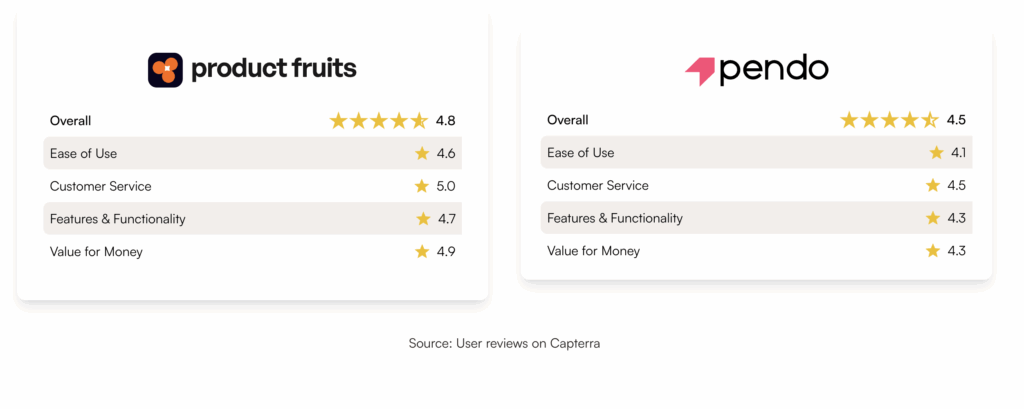
Check out how Product Fruits compares against Pendo in more depth here
1. Whatfix supports SCORM/xAPI exports for compliance and training
Whatfix enables organizations to export onboarding and training content in SCORM and xAPI formats, fully compatible with most Learning Management Systems (LMS). This makes it the go-to solution for industries and enterprises with strict compliance standards, or those needing to deliver structured, trackable training programs at scale.
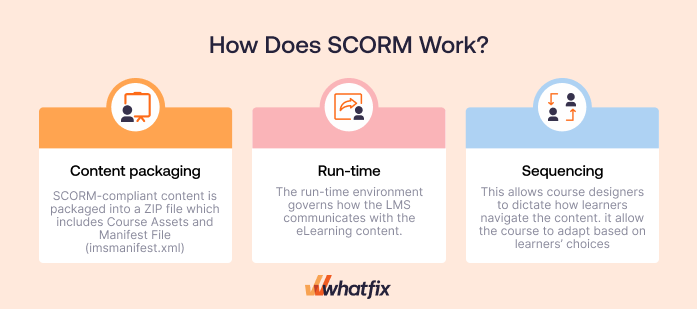
2. Whatfix empowers large-scale, multi-language onboarding rollouts
With automatic translation into 70+ languages, Whatfix lets global organizations create consistent onboarding and activation experiences across regions. Teams can deploy content to internal staff or customers worldwide, all without duplicating flows or manually recreating content in every language.
3. Whatfix excels at enterprise change management and complex workflows
Its robust platform supports not just customer onboarding, but also internal employee onboarding and enterprise-wide change management. Whatfix streamlines the adoption of complex software stacks, policies, or new tools—ensuring users quickly master multi-step workflows and reducing friction during organizational change.
4. Whatfix provides a no-code visual editor with extensive UI widgets
Any non-technical team member can use Whatfix’s intuitive drag-and-drop WYSIWYG builder to create personalized, branded onboarding guides. With extensive UI widgets like tours, flows, pop-ups, task lists, and smart tips, it’s easy to deliver in-app guidance that matches both product design and user context.
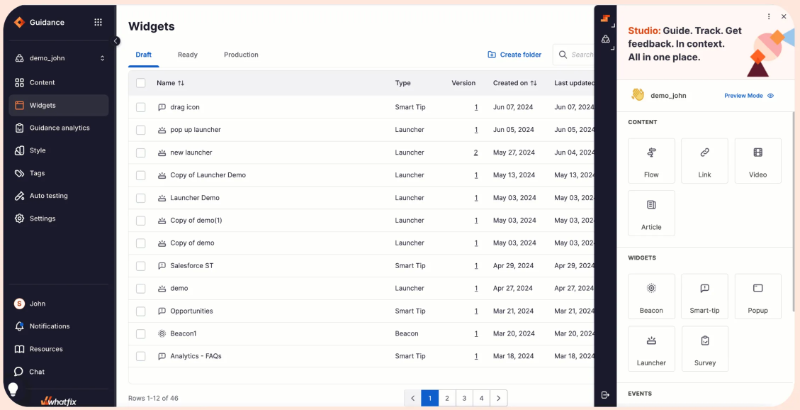
1. Heavier implementation and ongoing maintenance
Whatfix’s enterprise-grade features require extensive setup, often involving professional services and ongoing IT participation. This can drain resources and slow time-to-value for smaller or lean teams who need rapid onboarding solutions.
2. Custom pricing with growing Total Cost of Ownership (TCO)
Pricing for Whatfix is based on user volume, features, and service agreements—so costs can quickly climb, especially as businesses expand usage to include multiple languages, analytics, and LMS exports. Budgeting can be unpredictable for teams with evolving needs.
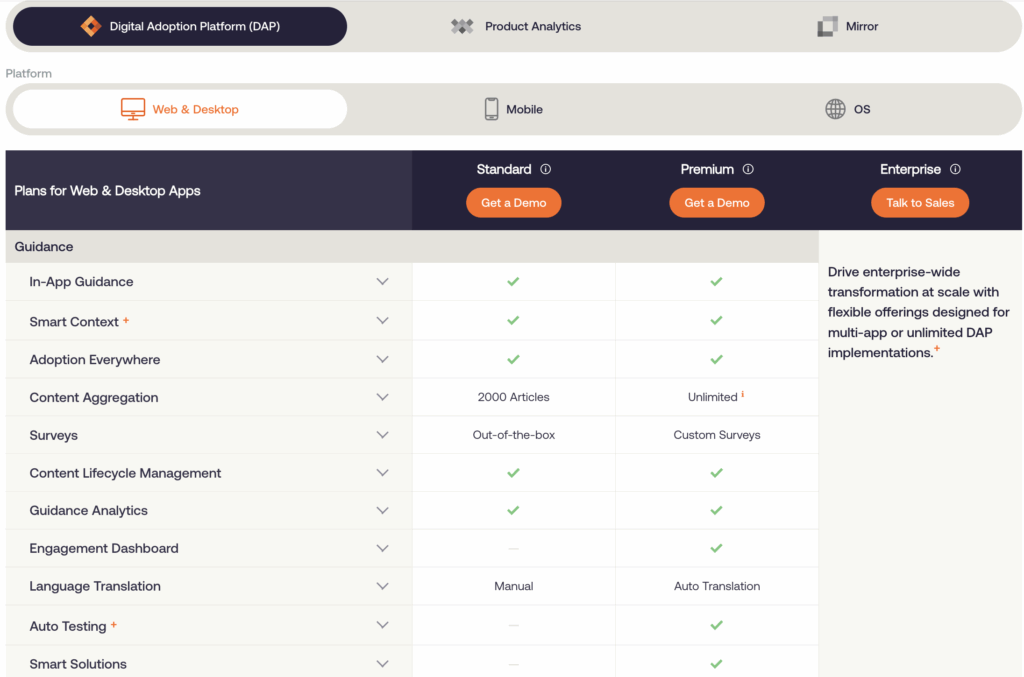
3. Overkill for simple onboarding needs
Smaller SaaS companies or products focused on fast, straightforward onboarding may find Whatfix’s broad capabilities and complexity excessive, resulting in inefficiencies and unnecessary costs when training-grade content or LMS integrations aren’t needed.
4. Less agility for fast iteration
Whatfix’s comprehensive governance and enterprise focus make it less nimble than platforms like Product Fruits or Userpilot. Teams may experience slower onboarding content updates and longer timeframes to roll out new experiences.
5. Complex UI and learning curve
While powerful, Whatfix’s feature-rich interface demands dedicated onboarding specialists or IT resources. Teams without specialized support may struggle with setup, customization, and fully leveraging the platform’s capabilities.
Product Fruits excels when your onboarding strategy needs to be fast, flexible, and highly accessible for small-to-mid SaaS teams, while Whatfix is a powerhouse for enterprise organizations needing formal training workflows and compliance-ready exports.
Product Fruits lets your non-technical PMs, marketers, or support leads create, launch, and adjust onboarding flows, checklists, and help content weekly—no engineering or professional services needed. Whatfix often requires heavy initial implementation and ongoing services support.
Product Fruits lets your non-technical PMs, marketers, or support leads create, launch, and adjust onboarding flows, checklists, and help content weekly—no engineering or professional services needed. Whatfix often requires heavy initial implementation and ongoing services support.
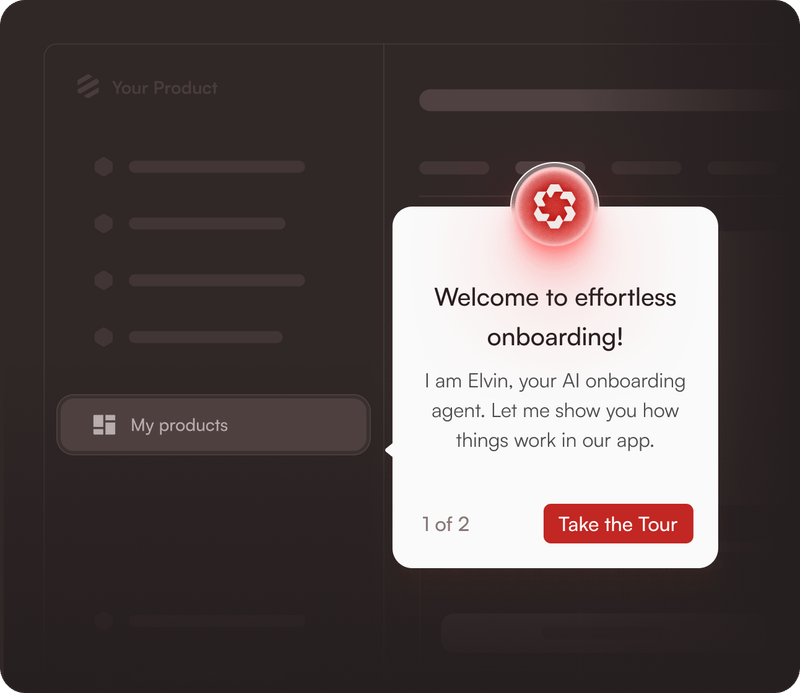
Product Fruits offers straightforward, usage-based pricing (monthly active users), making budgeting and stakeholder buy-in simple. Whatfix has opaque custom pricing that can rise quickly with expanded scope, add-ons, or analytics modules.
You can ship in-app surveys, NPS, and a contextual knowledge base directly inside Product Fruits. This helps you reduce support tickets and iterate on onboarding content—no need for external integrations as required in Whatfix.
It’s the best choice for startups and growth SaaS teams who value activation speed and simplicity over extensive training features, with low time to value. Whatfix is overkill unless you require SCORM/xAPI exports, enterprise change management, or multi-language internal onboarding.
Product Fruits allows easy branding, custom CSS, and rapid deployment of tooltips, tours, and announcements. No technical expertise required. Whatfix customization often comes bundled with lengthy implementation and sometimes doesn’t match the initial demo experience reported by users.
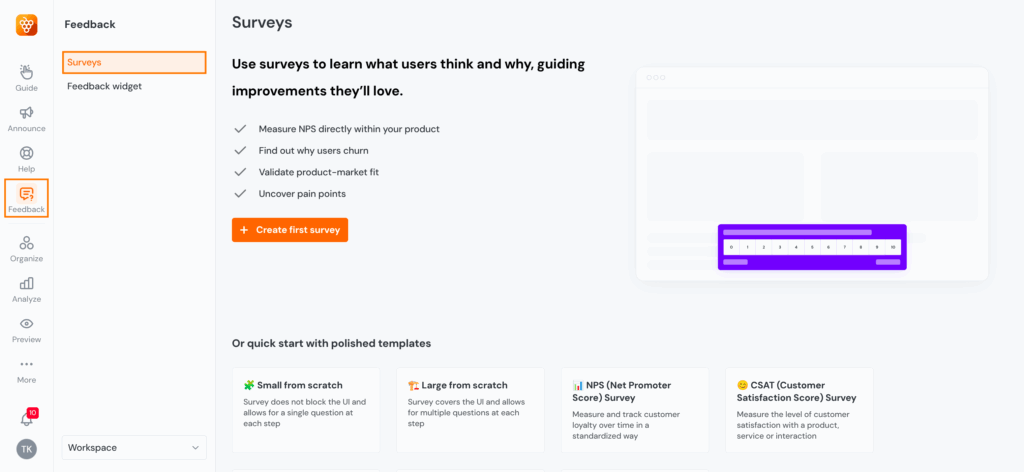
If your goal is to drive new user activation, introduce features, and reduce churn, Product Fruits is optimized for in-product engagement. Whatfix shines when onboarding is deeply tied to compliance and multi-app training, not just user activation.
Product Fruits receives top marks for ease of setup, support responsiveness, and intuitive design. Whatfix provides strong one-on-one support but often involves more calls and service hours due to product complexity.
Most teams launch functional onboarding flows within hours and see results immediately with Product Fruits. Whatfix can require weeks to months of onboarding, costing more in services and ongoing maintenance.
“Product Fruits provided us with an effective solution to reach all our players, whether they are on the Discord platform or not. We can now communicate directly with our users in real time on our platform, ensuring that no one misses important updates or offers without relying on emails. It’s not just about engaging users — it’s about driving real actions that positively impact on our bottom line” – Oscar Thorton, Product Manager, BAMG Sports
Read how BAMG Sports Drives user Engagement by 100% with in-app Announcements
| Feature / Aspect | Product Fruits | Whatfix |
|---|---|---|
| Primary Use Case | SaaS user onboarding & activation | Training, compliance, enterprise onboarding |
| Setup Time / Complexity | Fast, no-code (<1 day for MVP) | Longer, sometimes requiring services (>2 weeks) |
| Pricing Model | Transparent, MAU-based, budget friendly | Custom, complex, can escalate with scope |
| Surveys & Feedback | Native NPS, CSAT, quick to deploy | In-app surveys, custom available in Premium plan |
| Knowledge Base | Built-in and contextual | KB integration, not fully native |
| Brand Customization | Drag-and-drop, custom CSS, instant preview | Customizable with deeper setup |
| Analytics & Insights | Basic usage, onboarding success, guided next steps | Deeper analytics, event tracking, session replays |
| SCORM/xAPI Export | Not supported | Supported — ideal for LMS workflows |
| Multi-language Support | Yes, instant | Yes, with localization tools |
| Professional Services Needed | Rarely — most teams self-serve | Often — onboarding & ongoing maintenance |
| Best For | Fast-moving, non-technical SaaS teams | Enterprises, internal training, change management |
| Customer Support | High user ratings; fast, hands-on | Responsive but involves more service calls |
| Total Cost of Ownership | Predictable, low | Increasing with add-ons and implementation |
| Feedback from Real Users | Intuitive, easy, enables weekly iteration | Powerful but can be complex, service heavy |
Decision rule: If your primary metric is time‑to‑activation in a product, lean Product Fruits. If it’s training completion and LMS compliance, lean Whatfix.
Check out how you can choose between Whatfix and other user onboarding tools.
Chameleon excels in highly customizable onboarding experiences and deep integration with analytics platforms, making it ideal for teams that value granular control and already have an analytics-driven culture. However, Product Fruits stands out for teams seeking fast no-code onboarding, built-in tools for feedback and knowledge management, and AI-assisted onboarding flow sequencing.
1. Rich range of in-app messaging and UI patterns – Chameleon allows creating diverse onboarding elements like custom modals, slideouts, tooltips, hotspots, launchers (checklists or resource hubs), and more. These UI options offer flexibility to build varied and engaging user experiences beyond simple tours.
2. Good segmentation and personalization options – Users can either create segments inside Chameleon or import data from external sources like Mixpanel or Segment to deliver personalized onboarding experiences tailored to user attributes and behavior.
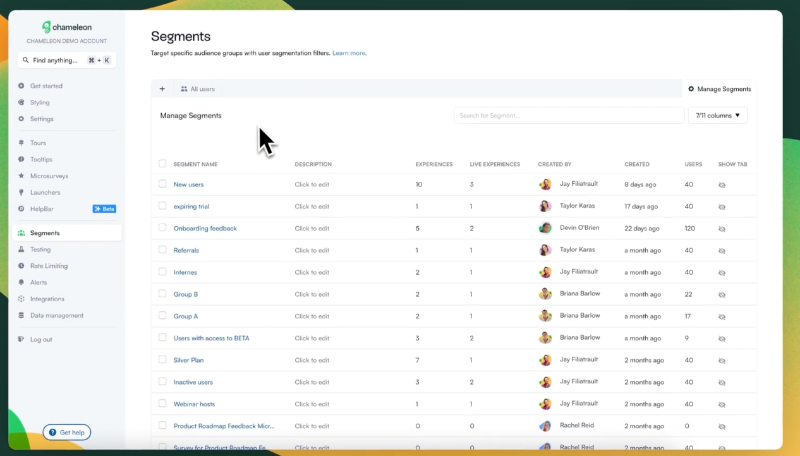
3. Supports onboarding for third-party and employee-facing tools – Beyond customer onboarding, Chameleon can be applied to employee onboarding inside SaaS and web applications, providing versatility in use cases.
4. Low-code approach – While not completely no-code, Chameleon minimizes engineering effort by offering a low-code interface suited for product teams wanting control but with reduced developer dependency.
5. User-centric onboarding – Chameleon focuses on modern onboarding approaches addressing pitfalls like impersonalization and frontloading. It promotes just-in-time teaching and optional tours initiated by users, improving engagement and reducing friction
1. No multi-page onboarding flows – Chameleon is designed for single-page apps and cannot create flows that span multiple URLs, which limits onboarding for multi-page or complex applications.
2. Lacks a full self-service resource center – While it has launchers (checklists or resource hubs), it does not provide an integrated self-service knowledge base where users can access multiple guides and tutorials or reach support.
3 Steep learning curve and partial coding needed – The tool isn’t entirely no-code. More complex customizations and advanced flows require CSS fluency and some coding knowledge, limiting accessibility to non-technical users.
4. Limited simultaneous in-app experiences – Unlike some competitors that allow running multiple onboarding experiences concurrently, Chameleon restricts this, which can reduce flexibility in user journeys
1. No-code onboarding with optional CSS customization – Product Fruits enables product managers and marketers to quickly build and iterate onboarding flows without CSS knowledge, while still offering optional CSS for teams that want brand-perfect styling. Chameleon often requires CSS fluency to achieve the desired look or advanced customization.
2. Built-in all-in-one surveys and knowledge base – Unlike Chameleon, which focuses mainly on onboarding experiences, Product Fruits includes native survey tools (NPS, CSAT) and a contextual knowledge base in the same platform. This helps consolidate tools, reducing ticket volumes and enabling faster iteration through direct user feedback.
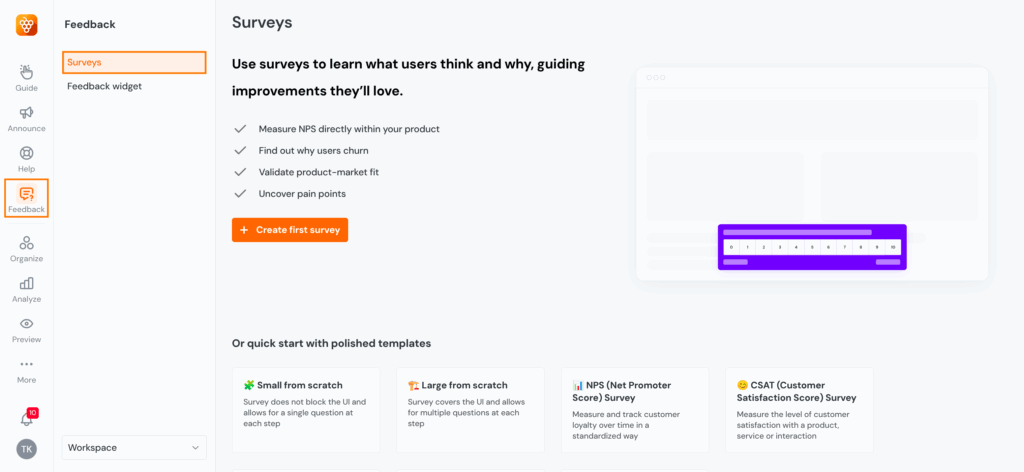
3. AI-assisted onboarding flow sequencing – Product Fruits uses AI to automatically adapt the next best guidance step for users based on behavior, helping teams accelerate activation and product adoption without manual flow updates. Chameleon has begun adding AI features but remains more manual and analytics-dependent.
4. Simpler integration and user analytics – While Chameleon integrates deeply with major analytics stacks like Amplitude and Mixpanel, Product Fruits offers lightweight event tracking and triggers combined with straightforward integrations, ideal for SaaS teams without in-house analytics teams.
5. Faster onboarding setup and adjustments – Product Fruits prioritizes ease-of-use and rapid deployment, allowing teams to launch product tours, checklists, and announcements immediately. Chameleon offers great flexibility but has a steeper learning curve and longer time to value.
6. Cost efficiency for SMBs and growth-stage companies – Product Fruits offers more budget-friendly pricing with clear packaging and fewer professional services needs compared to Chameleon’s premium pricing and sometimes complex billing tiers.
7. Focus on activation and retention over deep analytics – Product Fruits helps SaaS teams drive product adoption through in-app engagement and user feedback rather than relying heavily on external analytics platforms for insights, making it ideal for fast-moving teams that want quick wins, and higher activation rates.
“Integrating an in-app feedback widget with our Slack channel enables us to swiftly address user issues on our platform and gather important feedback for future product development. Additionally, product improvements are measured through in-app surveys and tracked over time for comparison. Consistently applying this approach across multiple surveys and with thousands of users has enabled us to boost our net NPS score by 40%.” – Sarthak Sarin. Product Manager, Factors AI.
Read how Factors AI increased their product NPS score by 40%
| Feature / Aspect | Product Fruits | Chameleon |
|---|---|---|
| Customization | Drag-and-drop no-code with optional CSS | Highly customizable, CSS knowledge beneficial |
| Surveys & Feedback | Built-in NPS, CSAT, in-app surveys | Surveys available but less consolidated |
| Knowledge Base | Native, integrated with onboarding | Self-serve help widgets, not a full KB |
| AI-Assisted Sequencing | Yes, adapts guidance flows automatically | Emerging AI features, mostly manual control |
| Analytics Integration | Lightweight tracking, simple third-party integrations | Deep integration with Amplitude, Mixpanel |
| Ease of Use | Intuitive UI, fast setup, great for non-technical users | More complex, steeper learning curve |
| Pricing Model | Transparent, MAU-based, affordable | Premium pricing, higher cost for startups |
| Ideal For | SMBs, SaaS teams focused on activation and retention | Product teams needing granular UX control |
| Support & Onboarding | Highly rated, quick support and onboarding | Good, but complex implementations require time |
| A/B Testing | Basic to moderate capabilities | Robust A/B testing features |
| Event Analytics | Basic in-app analytics | Limited native analytics, relies on external |
Decision rule: If your priority is crafting highly bespoke UI patterns and you’ve got CSS chops, go Chameleon. If it’s shipping fast, learning faster with a unified stack, go Product Fruits.
Check out how Product Fruits compares against Chameleon here.
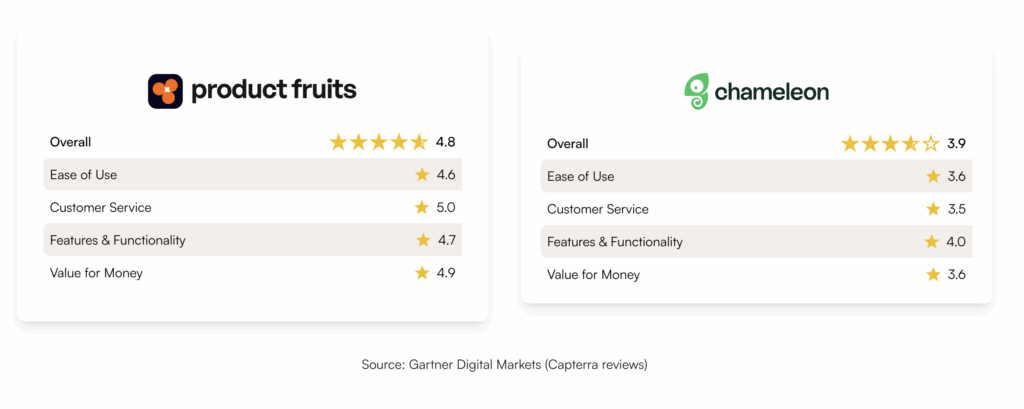
Userpilot is known for its advanced behavior-driven onboarding experiences and deep analytics, suiting mid-market SaaS teams focused on activation experiments and segmentation. However, Product Fruits shines for smaller or non-technical teams that want a unified, simpler pricing model including built-in surveys and knowledge base, plus AI-assisted orchestration of onboarding flows.
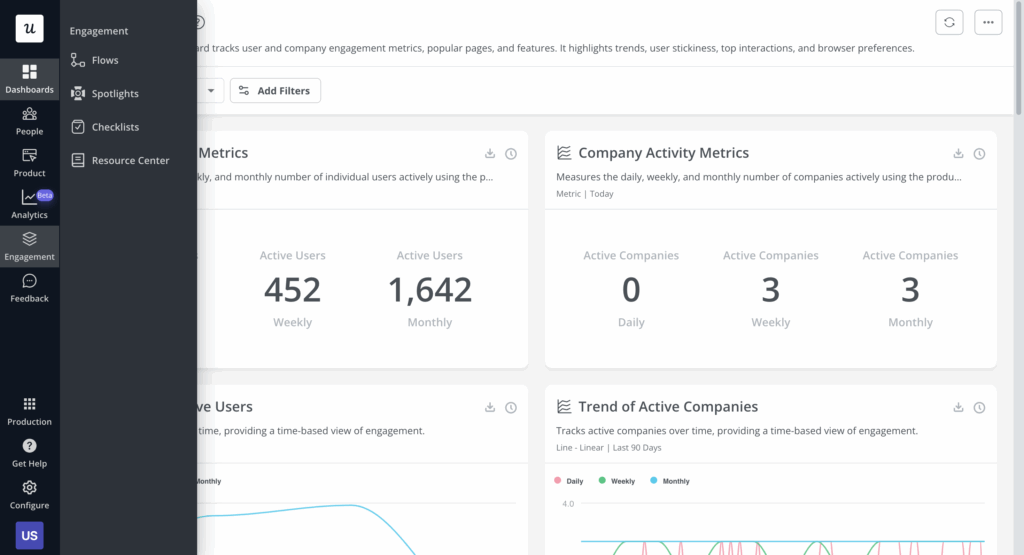
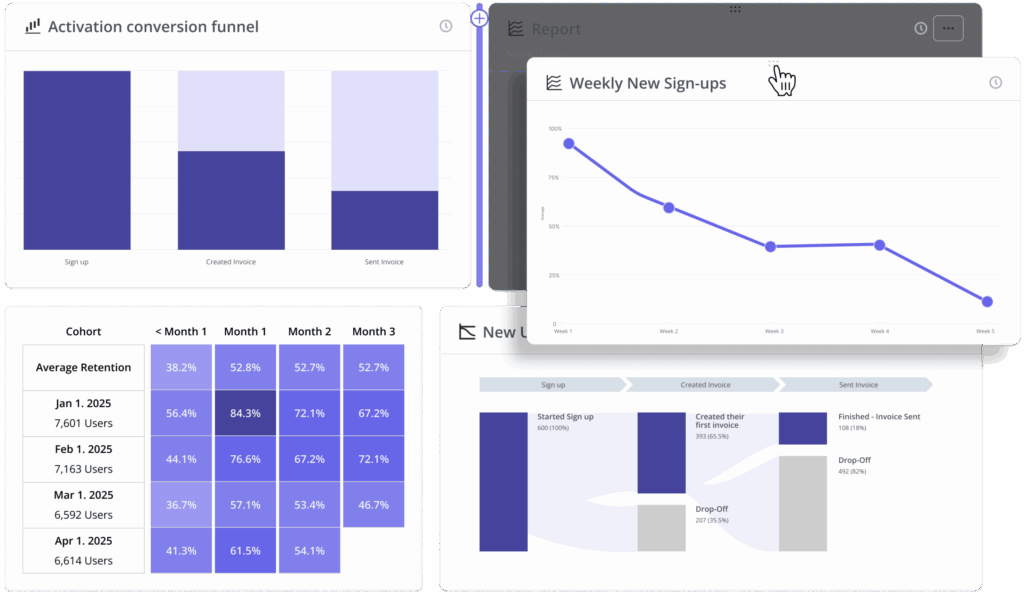
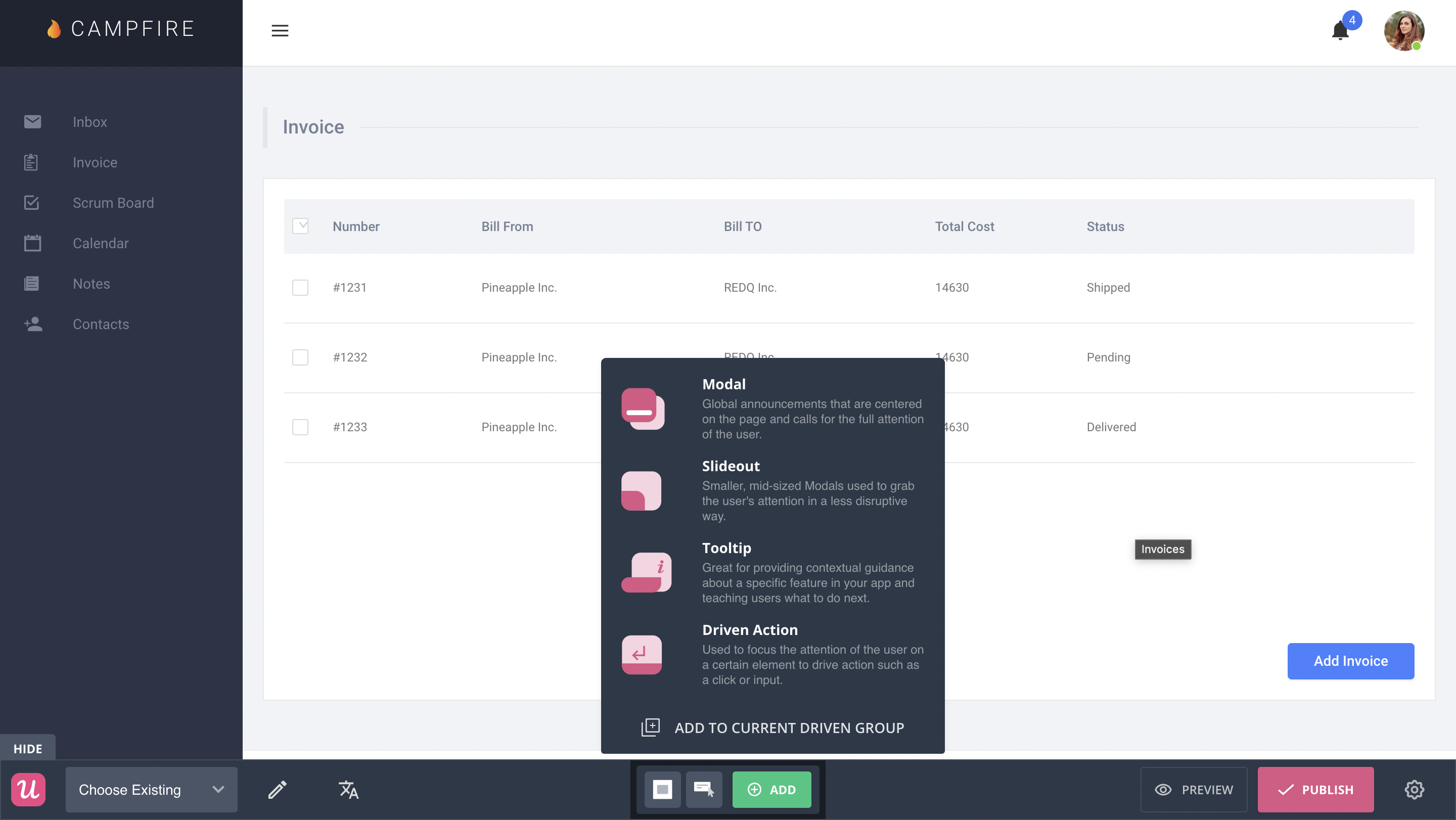
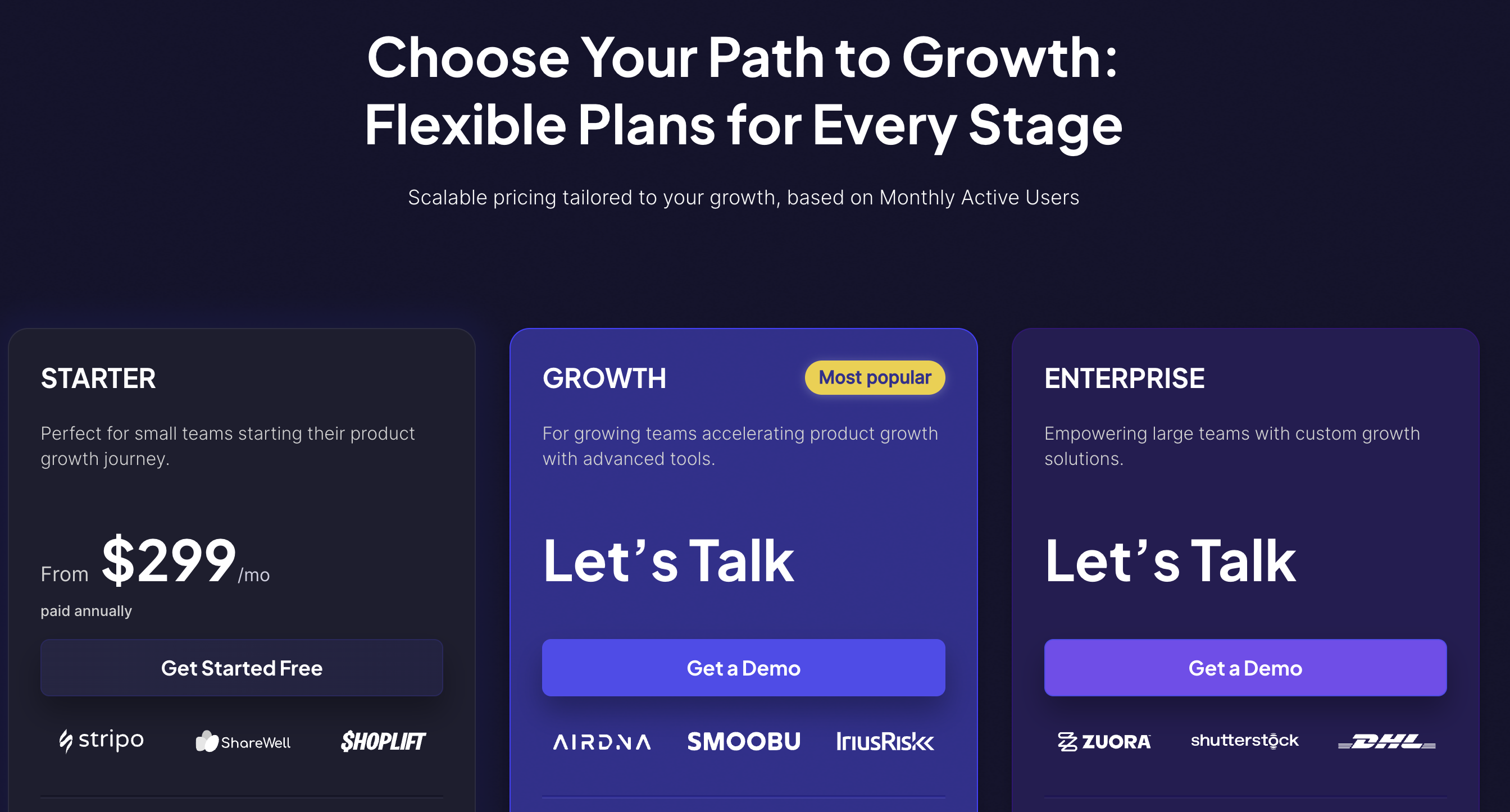


“The Product Fruits platform addressed several challenges we faced with our internal software. As a financial institution, we work with robust and highly secure software. By integrating no-code onboarding, we enable 24/7 training for our employees, saving our service departments many hours each month” – Michal Kozub, Digitalization Leader, Direct Insurance Group.
Read the full case study on how Direct Insurance saves 30 hours a month on employee training
| Feature / Aspect | Product Fruits | Userpilot |
|---|---|---|
| Primary Strength | Fast, no-code onboarding + AI-driven sequencing | Behavior-driven onboarding + advanced analytics |
| Pricing Model | Transparent MAU-based, all-in-one packages | Tiered pricing, add-ons increase cost |
| AI Assistance | Adaptive onboarding flow orchestration | AI-assisted content creation and analytics |
| Surveys & Feedback | Built-in NPS, CSAT surveys + native knowledge base | Strong surveys, less emphasis on KB |
| Analytics & Reporting | Basic user insights, activation focus | Advanced funnel, feature adoption, user behavior |
| User Segmentation | Limited to core targeting | Extensive, attribute and behavior-based |
| Ease of Use | Intuitive UI, quick setup, ideal for non-technical users | Powerful but steeper learning curve |
| Customization | Drag-and-drop, optional CSS customization | Deep customization with code-free visual builder |
| Experimentation | AI-driven sequencing enables fast iteration | Manual setup of activation experiments |
| Customer Support | Highly rated, hands-on onboarding | Good support but more complex setup |
| Ideal For | Small teams, startups needing fast activation | Mid-market SaaS with data-driven product teams |
Decision rule: If your constraint is team bandwidth and tool sprawl, Product Fruits reduces overhead. If your constraint is analytical control on the web and you’re comfortable with complexity, Userpilot delivers.
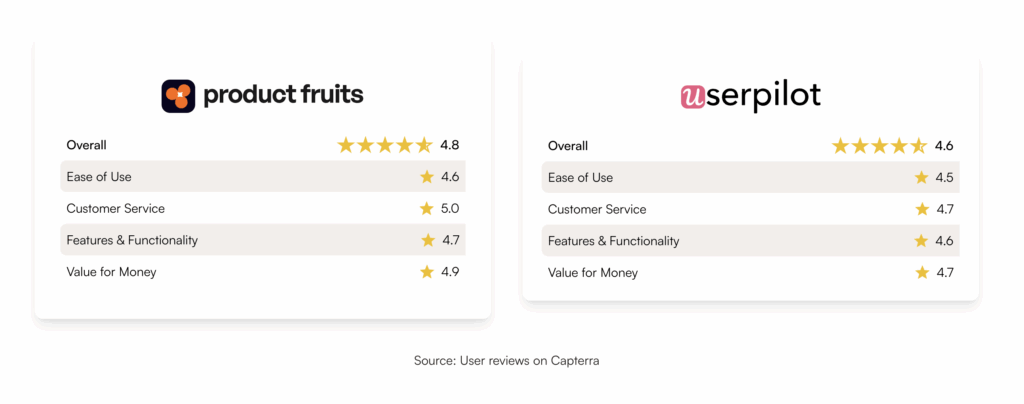
Check out how Product Fruits compares against Userpilot here.
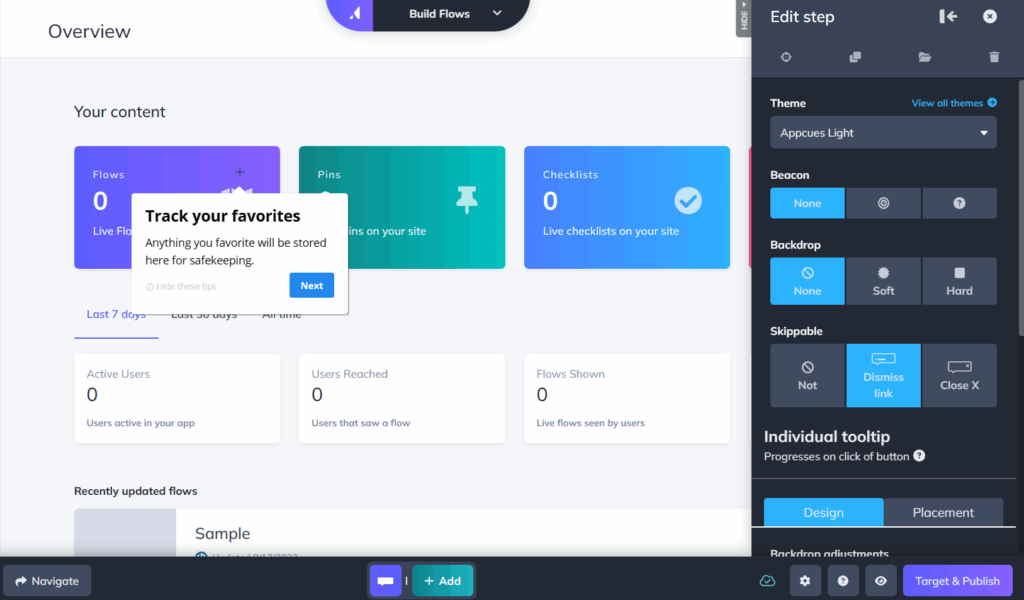
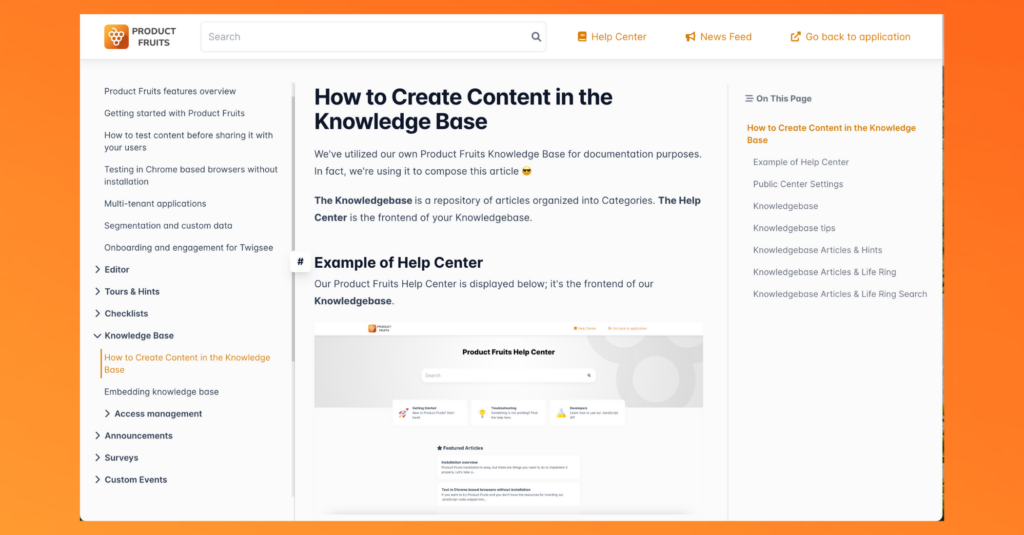
“With Product Fruits’ onboarding elements, we managed to reduce the volume of support tickets by 25% and reallocate our support team to implementation workshops for new customers”- Soufiene Chahbani, Product Owner, Nodes and Links
| Feature / Aspect | Product Fruits | Appcues |
|---|---|---|
| Onboarding Builder | No-code, drag-and-drop, optional CSS | No-code drag-and-drop, easy for PMs |
| Surveys & Feedback | Built-in NPS, CSAT, in-app surveys | NPS surveys, basic feedback tools |
| Knowledge Base | Native, contextual, integrated | Requires integration with external KB tools |
| AI Personalization & Sequencing | Yes, AI-driven adaptive flow sequencing | No AI orchestration, manual flow management |
| Pricing Model | Transparent, MAU-based, predictable | Tiered pricing, escalates with MAUs and features |
| Targeting & Segmentation | Advanced segmentation without add-ons | Good but some segmentation locked behind tiers |
| Analytics & Reporting | Basic to moderate product insights | Basic analytics, event limits on lower tiers |
| Customization Depth | Optional CSS, branding flexibility | Good branding, limited deep customization |
| Multi-device Support | Web and mobile support | Web and native mobile onboarding |
| Ease of Use & Setup | Highly intuitive, fast setup | Very user-friendly but some reliance on engineering |
| Customer Support & Onboarding | Highly rated, hands-on onboarding | Good support, but complex setups may require eng. |
| Ideal For | SMBs and mid-markets needing integrated onboarding tools | Mid-market to enterprise scaling onboarding needs |
| Feature Scalability | Scales smoothly with growing product needs | May require plan upgrades, which increase costs |
Decision rule: For speed + simplicity, both fit. For speed + compounding learning with AI and consolidation, Product Fruits pulls ahead.
Check out alternatives to Appcues in more detail in this blog post.
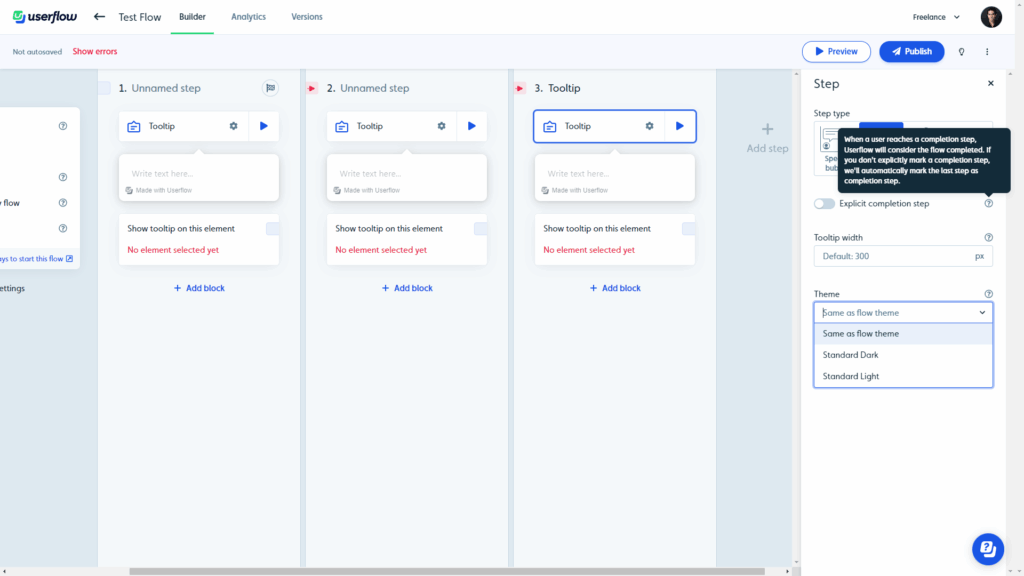

“Our user onboarding today is faster, intuitive, and self-served. With the implementation of the Product Fruits platform, our Product Team has successfully minimized their regular repetitive tasks, resulting in a 20% reduction in their overall workload. This saved time allows us to allocate more resources towards in-depth analytics and client-led tasks” – Tomas Netrval, Product Manager, Keboola
Read the full case study on how Keboola accelerated its user onboarding by 29%
| Feature / Aspect | Product Fruits | Userflow |
|---|---|---|
| Onboarding Setup Speed | Fast, no-code, rich builder | Extremely fast, simple checklist-focused |
| AI Assistance | AI-assisted flow orchestration and content generation | AI chatbot and assistant for user support |
| Pricing Model | Transparent MAU-based pricing | Startup and Pro packages with clear tiers |
| Surveys & Feedback | Built-in NPS, CSAT, journey-linked surveys | Limited native survey features |
| Knowledge Base | Native, embedded KB for self-service support | Basic resource centers, less integrated |
| Personalization & Targeting | Advanced segmentation and targeting | Basic segmentation, less granular |
| Analytics & Reporting | Basic to moderate product analytics | Limited built-in analytics, relies on integrations |
| Integrations | Several integrations, easy to extend | Limited native integrations |
| Ease of Use | Intuitive UI, easy for PMs and non-tech users | Very simple, minimal learning curve |
| Best Suited For | SMBs and growth-stage SaaS needing AI orchestration | Startups and teams needing fastest flow creation |
| Customer Support | Highly rated for responsiveness and onboarding | Good support, focuses on ease of use |
Decision rule: If you view onboarding as a checklist and help hub, Userflow is a clean fit. If you view it as a growth system that learns, Product Fruits fits better.
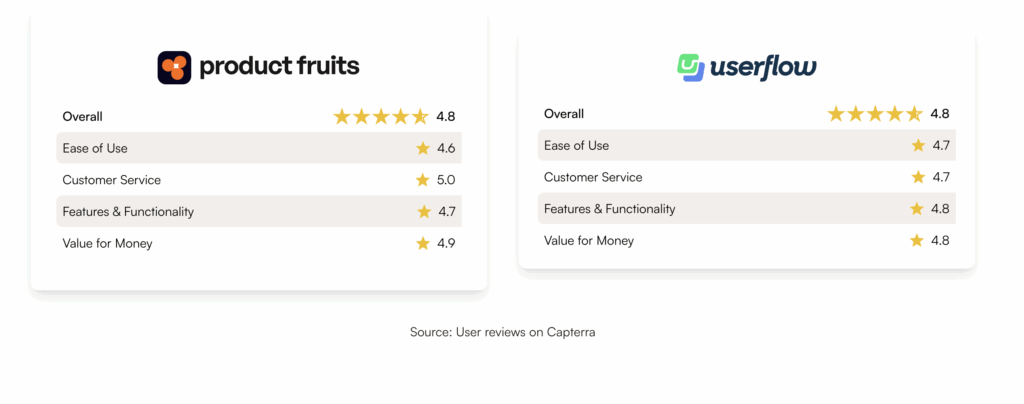
Check out how Product Fruits compares to Userflow here.
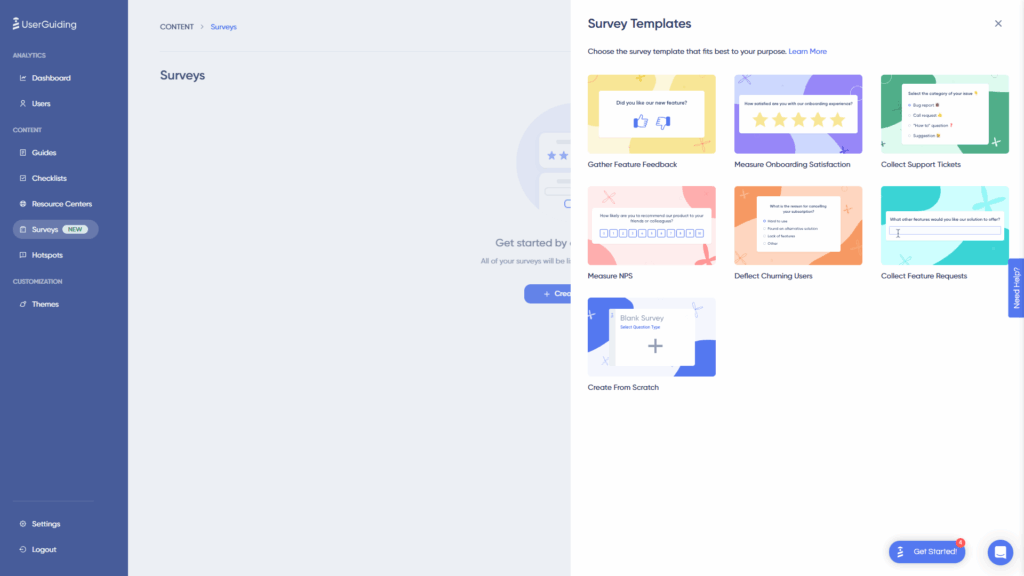
Product Fruits offers predictable MAU-based pricing, often more cost-effective as your user base grows compared to UserGuiding’s tiered pricing model with costly upgrades.
Product Fruits includes AI to automatically adapt and sequence onboarding flows for optimized user activation without manual intervention, a feature UserGuiding doesn’t provide.
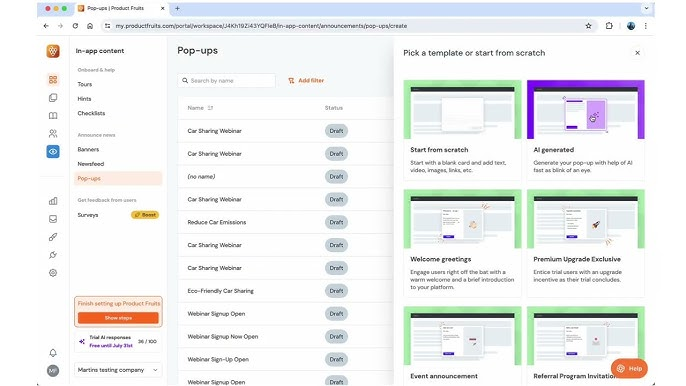
Product Fruits consolidates onboarding, surveys (NPS, CSAT), and an embedded knowledge base, simplifying your tech stack and reducing tool fragmentation.
Product Fruits’ no-code builder prioritizes quick content creation and iteration by PMs and marketers without needing CSS or engineering, while UserGuiding often requires CSS for deeper customization.
Product Fruits provides flexible user segmentation for personalized onboarding experiences beyond the more limited segmentation capabilities of UserGuiding.
Product Fruits ranks higher in customer service satisfaction with more hands-on onboarding help and migration support for switching from other platforms like UserGuiding.
“Our old support method was complicated, costly, and most important: not user-friendly. With Product Fruits, we now resolve 26% more tickets and deliver support right inside the product”- Rens Hoekstra, Product Designer, Outsmart International
| Feature / Aspect | Product Fruits | UserGuiding |
|---|---|---|
| Onboarding Builder | No-code, rapid, optional CSS customization | No-code, drag & drop, CSS often required |
| Surveys & Feedback | Built-in NPS, CSAT, immediate in-app surveys | In-app NPS and surveys, separate survey widgets |
| Knowledge Base | Native, embedded, contextual | Standalone resource centers optionally |
| AI Personalization | AI-driven adaptive onboarding sequencing | No built-in AI orchestration |
| Pricing Model | Transparent MAU-based, cost-effective at scale | Tiered pricing, can become costly at scale |
| Segmentation & Targeting | Advanced user segmentation and targeting | Behavioral segmentation with conditional logic |
| Analytics & Reporting | Basic funnel and engagement insights | Basic onboarding analytics |
| Customization Depth | Custom CSS optional, simple no-code UI | Templates plus CSS customization |
| Multi-language Support | Yes, multi-language onboarding | Yes, multilingual support |
| Ease of Use for Non-Tech Users | High, fast iteration without engineering | Good but some CSS necessary for advanced styling |
| Support & Onboarding | High rated, dedicated migration support | Strong support, more DIY onboarding |
| Ideal For | SMBs, fast-growing SaaS aiming for AI onboarding | Companies needing robust onboarding templates |
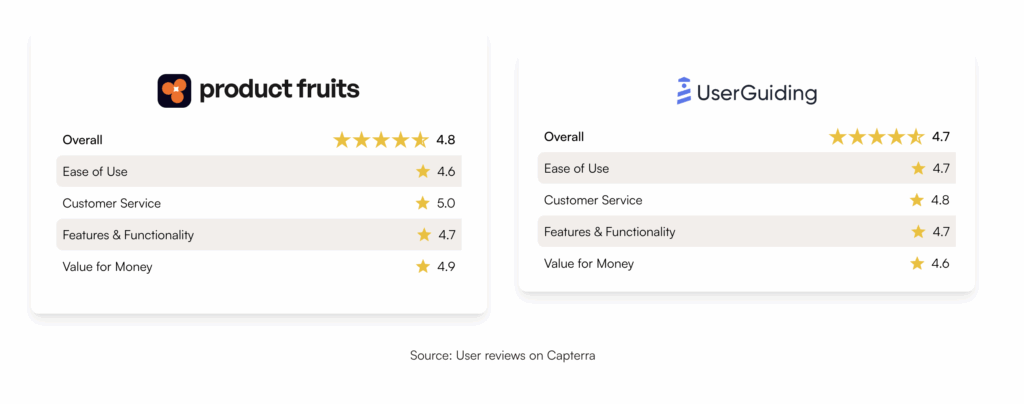
Check out how Product Fruits compares to User Guiding here.
| Capability | Product Fruits | Pendo | Whatfix | Chameleon | Userpilot | Appcues | Userflow(s) | UserGuiding |
|---|---|---|---|---|---|---|---|---|
| No‑code tours/tooltips/hints | ✓ | ✓ | ✓ | ✓ | ✓ | ✓ | ✓ | ✓ |
| Checklists | ✓ | ✓ | ✓ | ✓ | ✓ | ✓ | ✓ | ✓ |
| In‑app announcements/newsfeed | ✓ | ✓ | ✓ | ✓ | ✓ | ✓ | ✓ | ✓ |
| Built‑in surveys (NPS/CSAT/CES) | ✓ (AI‑assisted) | ✓ (NPS) | ✓ | Limited native; leans on integrations | ✓ | ✓ | ✓ (limits on lower tiers) | ✓ |
| Built‑in knowledge base | ✓ (native) | Integrations | Integrations/knowledge hubs; not a core native KB | Integrations | Integrations | Integrations | Resource center (no full KB) | ✓ (native KB) |
| AI personalization/orchestration | Adaptive sequencing | Emerging AI assistants | Authoring assist; training flows | Creation/testing assist | Expanding (web + mobile) | Limited | Assistant/chatbot | Assistant |
| Deep styling w/ custom CSS | ✓ | ✓ | ✓ | ✓✓ | ✓ | ✓ | ✓ | ✓ |
| Mobile (native SDKs) | Web‑first | Web + mobile | Web + mobile | Web (embeds) | Web + native mobile | Web + mobile | Web | Web (no native mobile) |
| Analytics depth | Journey‑tied, focused | Enterprise‑grade | Solid usage + training | Light native, strong via integrations | Robust web analytics | Basic to moderate | Basic to moderate | Basic |
| Pricing model | Transparent MAU tiers | Custom (MAU‑based) | Custom | Tiered by MTU | Tiered by MAU (some custom) | Tiered by MAU | Tiered by MAU | Tiered by MAU |
Interpretation, not hype: Product Fruits wins where consolidation, adaptive guidance, and speed matter. It trades maximum analytics depth for operational agility.
Friction isn’t the enemy. Un‑earned friction is. Pick the platform that earns attention, accelerates learning, and respects your team’s bandwidth. For most mid‑market and growth SaaS teams, that’s Product Fruits — not because it does everything, but because it does the right things together and lets you iterate at the speed of your users.
What is “user activation,” exactly?
Activation is when a new user experiences your product’s core value for the first time — often captured by milestones like creating a first project or connecting a first integration. It’s a leading indicator of retention and expansion.
How does AI actually improve onboarding?
AI analyzes behavior and context to tailor messaging, steps, and timing automatically. Instead of static, one‑size‑fits‑all tours, users get dynamic guidance that adapts in real time — which shortens time‑to‑value and reduces manual campaign management.
Can Product Fruits replace our knowledge base and survey tools?
For many teams, yes. Product Fruits includes a configurable knowledge base, an in‑app support launcher, and robust surveys (NPS, CSAT, CES, custom), so you can consolidate tools and measure more of the journey in one place.
We’re non‑technical. Will the experiences be on‑brand?
Yes. Product Fruits is no‑code for layout and logic and supports custom CSS for pixel‑perfect control — without heavy developer involvement.
How does Product Fruits compare on price?
Generally more transparent and predictable than enterprise tools with opaque pricing. Plans are aligned to monthly active users for clean budgeting. Always verify the current plan for your MAU band..
Can I run Product Fruits alongside Amplitude or GA?
Yes. Many teams pair their analytics stack with Product Fruits to combine deep analysis with AI‑optimized in‑app guidance. Check integrations and event pass‑through options during setup.
How do we measure success after implementation?
Track time‑to‑activation, activation rate by segment, step‑level drop‑off, NPS/CSAT, D7/D30 retention, and feature adoption. Iterate weekly on the highest‑drop‑off steps, and let AI optimization run to convergence.